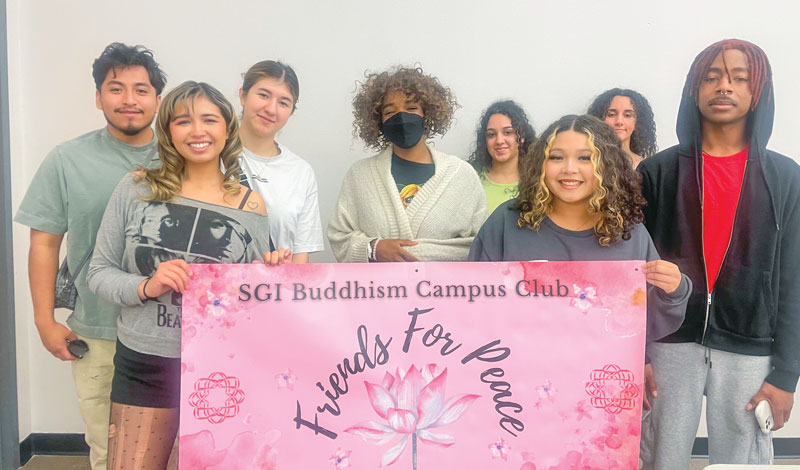Ikeda Sensei felt the time had come for the philosophy of Buddhism, rooted in human rights and peace, to be transmitted to the world. On August 31, 1962, he began his lectures on The Record of the Orally Transmitted Teachings for student division representatives. The following excerpt recounts his first lecture with 40 student division members. Sensei appears as Shin’ichi Yamamoto in the novel.
To Shin’ichi Yamamoto, these leaders of the student division—the last division formed by Josei Toda—were diamonds in the rough his mentor left to him. He vowed to take these rough gems with their potential for limitless brilliance and polish each of them with care until they sparkled as beautiful as jewels of talent and ability. …
“As for each of you here today to study the Orally Transmitted Teachings with me, from here on, I ask that you, too, without a single exception, develop yourselves to become exemplary leaders of the Soka Gakkai and of society as a whole. That is my earnest wish. For that reason, I am determined to put everything I have into these lectures, no matter how busy I may be with other matters.
“I also want you to know that I will be looking out for you as long as I live. I will be there to see how many of you go on to become outstanding leaders—great eagles and lions of faith—and who falls by the wayside or ends up turning against the Soka Gakkai.
“Buddhism is strict. Half measures won’t work. Either you persevere in upholding faith throughout your life and attain Buddhahood, or you abandon your faith and suffer as a result. You may be active as top leaders of the Soka Gakkai for as long as 20 or 30 years, but unless you maintain your faith to the very end, your lives will be failures, defeats. And I don’t want to see this happen to any of you.”
Shin’ichi’s voice rang with conviction. Everyone listened intently, their expressions serious. No one so much as moved or made a sound. …
When Shin’ichi had given the students a basic overview of the writing’s structure, he said, “Now let’s begin our study of the Orally Transmitted Teachings, exploring it together both in principle and in practice!”
He then asked for a volunteer to read its opening lines aloud. For a moment, no one raised a hand. Then, slowly, a few hands went up. Shin’ichi picked one student, who stood and began to read, his voice weak and hesitant:
“Nam-myoho-renge-kyo
“The Record of the Orally Transmitted Teachings (Ongi kuden) says: “Namu or nam is a Sanskrit word. Here it means to dedicate one’s life” (OTT, 3).
When the reader finished, Shin’ichi said with some severity: “What lackluster reading! When we read Nichiren’s writings, we should do so with the profound conviction that we are reading the truth, the absolute truth—that this is exactly how it is. In other words, we should read with faith seek with faith and understand with faith.
“Western philosophy may begin from doubt, but when we are studying Buddhism, we must begin with faith. Even Shariputra, said to be foremost in wisdom among Shakyamuni’s disciples, attained enlightenment not through his knowledge or intellect but through faith.”
A solemn atmosphere pervaded the room. With serious expressions, everyone sat up straight and listened.
“Nichiren’s writings are scripture, a compilation of the Buddha’s words,” Shin’ichi continued. “Each word and phrase is important. And especially when it comes to The Record of the Orally Transmitted Teachings, if we seek to understand it deeply, we should first read it aloud again and again in a clear, strong voice—to the point where we have practically memorized it.
“Also, we should read his writings in action, word and thought. This means resolving to live according to it: sharing its philosophy with others and practicing its teachings ourselves. Our actions must match our convictions. That is the attitude with which to approach the study of Buddhism, and it is also a basic premise of Eastern philosophy.”
The participants felt as if they had been jolted awake. They couldn’t help feeling ashamed that until that moment they had simply assumed it was enough to just sit back and listen to the lectures. (The New Human Revolution, vol. 6, revised edition, pp. 281–85)
Happier Than Ever

Name: Ameera Lateef
City: Las Vegas
School: University of Nevada, Las Vegas
Living Buddhism: Hi Ameera. How did you start practicing Buddhism?
Ameera Lateef: My mother practices with the SGI, so I’ve always been involved. But I began seriously chanting after the Student Division conference at the Florida Nature and Culture Center last year. Being around that many young people my age who were practicing Buddhism inspired me. It felt like the first time I had ever truly chanted. I decided to take my practice seriously and started consistently chanting every morning and evening from then on.
Did you see any benefits?
Ameera: Yes, within a week, I reconnected with a family member who I hadn’t spoken to in a year. I knew there was no other explanation other than because I was chanting for her happiness. I realized that her and I have a karmic bond from past lifetimes, and I sincerely felt compassion for her in a way that I never had before. Now we are genuine friends. It all started with my prayer for her happiness.
That’s really encouraging. You started the University of Nevada, Las Vegas campus club at the same time?
Ameera: Actually, I was asked to support the club before the conference, but afterward felt even more pumped about it. We’ve held around six meetings and my friends support in getting the word out. I was taking online classes last year, so I was rarely ever on campus, but a friend of mine, who doesn’t yet practice Buddhism, volunteered to give out flyers for our meetings!

Out of her own volition?
Ameera: Yes. Buddhism often comes up naturally in conversations at school, so she’s heard me talk about my practice a lot. And when she stays the night, my mom and I take her to Soka 2030. When I was talking about our club meeting, she offered to support by telling people about it. She was recently visited by SGI leaders who were in town, and she was so moved by their warmth. She said, with tears in her eyes, “I love these people!” My other friend from high school just recently received the Gohonzon! I find that the people who are closest to me are the people who are most attracted to the practice.
Why do you think that is?
Ameera: I’m happier than I’ve ever been, and I strive to show actual proof of my Buddhist practice to my friends. Recently, I went through a breakup. In past breakups, my suffering consumed me, and I felt like I was drowning with no life jacket. But this time around, I took responsibility for my own actions. The entire process was full of love and compassion, and I didn’t have any anger or despair.
What are your club activities like?
Ameera: They are very informal. Recently, we have been talking about Buddhism in everyday life. Sometimes, for example, we talk about Buddhist concepts in TV shows. Other times we study the Living Buddhism. We always have guests attending our meetings and our region leaders support us too!
What do you think young people are struggling with most?
Ameera: Cynicism. I see it in my close friends. It’s hard for youth to think positively these days. The mind is powerful. Choosing a different word to alter perspective can change everything. Buddhism gives people the tools to shift their mindset and take charge of their lives. It’s so important for people to know that they are in control of their happiness.
Is that why the campus club is important?
Ameera: Yes, and it’s also crucial that people have a safe place to go on and off campus—somewhere to bring their deepest troubles and concerns. We can’t give people the answer to solving their problems, but through Buddhism, they can find those answers within themselves. It’s also about finding community. Going to a district meeting, for example, wipes out all of my worries from the past week. The campus club meetings provide that same type of space.
What are your goals and dreams for the future?
Ameera: I want to be happy. I used to worry about my future, but now I know I’m going to be passionate about whatever I do. And whatever it is that I end up doing in the future, I’m going to accept and love the hardships that come with fulfilling that dream.
You are reading {{ meterCount }} of {{ meterMax }} free premium articles

